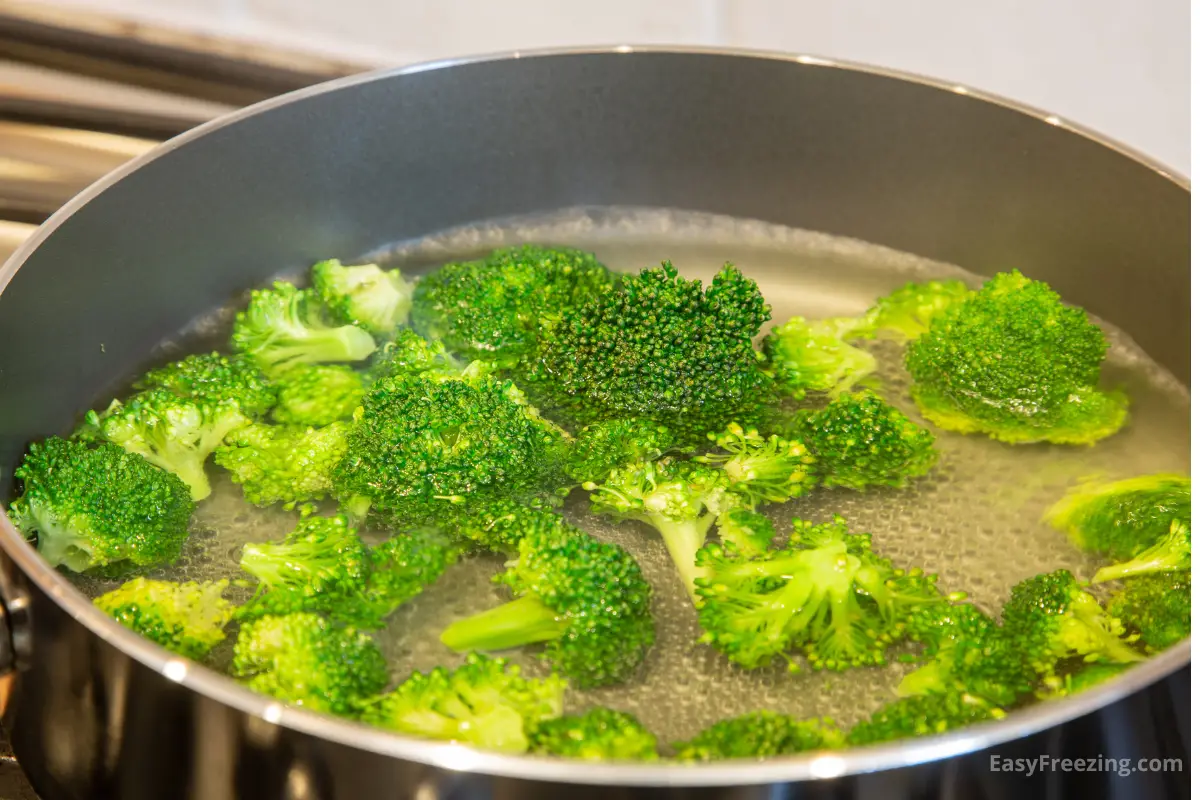How Long To Blanch Broccoli For Freezing (Explained)
Serve it raw or cooked, with soups, as a pizza topping, or in salads, broccoli is one of spring’s plentiful and highly versatile vegetables. Not only this, but it is also loaded with the goodness of vitamin C, potassium, and dietary fibers.
Since fresh broccoli goes bad after a week or so in the fridge, the best way to keep it long-term is to freeze it. However, before you can freeze broccoli, you’ll need to blanch it in order to preserve the overall quality and taste.
Blanching (partially cooking) broccoli helps to preserve its bright green color and its texture by eliminating the natural enzymes in the broccoli that will cause it to get limp and mushy when frozen. It also tenderizes the veggie while still keeping it crisp.
But how long to blanch broccoli for freezing?
Broccoli should be blanched in boiling water for about 2-3 minutes. If you’re blanching broccoli using steam, it will need to be blanched for approximately 5 minutes.

How to Blanch Broccoli
Blanching involves dipping the veggie into boiling water for a short period of time and then plunging it into ice-cold water so that it doesn’t get fully cooked. According to Wikihow, blanched vegetables retain up to 1300% more nutrients as opposed to their non-blanched counterparts. Doing this will also remove all the dirt from the surface of your vegetable.
Broccoli is notoriously famous for having a dull and mushy taste once we blanch it, but this only happens when you over-blanch it. Worry not though, here is an easy step-by-step guide that will help you get delicious, bright and crisp broccoli ready for freezing every time!

Preparing Broccoli for Blanching
Wash your broccoli and check if the trunk is dry or woody. Then take a knife or a potato peeler and scald the edges & outer layer of the stalk until you reach the tender part. Separate the crown into smaller pieces and cut the trunk into tiny slices, which can be added to stir fries. Make sure to evenly dice all the florets to roughly the same size so that they cook evenly.
Tip: When buying broccoli to blanch and freeze, go for bright green broccoli with a firm stalk and be sure to avoid any with brown spots.
Boil Water For Blanching Broccoli
Take a pot large enough to hold the amount of broccoli you have (along with some extra room) and fill it up to two-third of its height with water. Cover it and then turn on the heat.
Once you see tiny bubbles and some steam coming out from under the lid, add one tablespoon of salt to the water for seasoning. Adding some salt will also raise the boiling point of your water, helping to ensure that you do not overcook your veggies.
While the water boils, prepare an ice bath where you will transfer the broccoli after it’s been blanched. For this, simply fill a large bowl with water and add 7-8 ice cubes in it.
How Long to Blanch Broccoli?
Blanching broccoli for about 2-3 minutes yields the best results. If you like it on the softer side, leave the broccoli in the boiling water for an additional minute. If you leave it for too long, however, the outer layer can become soggy.
To check this, use a fork and see if you are able to pierce through the broccoli or not. If you can easily pierce it without any resistance, it means that your broccoli is over-blanched. Properly blanched broccoli has some resistance and firmness on the inside.
Tip: Set a Timer When Blanching Broccoli
Take your prepped broccoli and gently pour the florets into the boiling water. As soon as you do this, start a timer for two minutes and wait. For effective blanching, the flowers should be cut into small 1 ½-inch pieces and spread evenly across the boiling pot.
As soon as the timer runs out, remove the broccoli. The texture should be firm, but also slightly softened when you remove it. Some vegetables turn quite soft post blanching, so always use a spoon or a sieve to take them out. You can also drain the broccoli in a colander.
Cool The Broccoli in an Ice Bath
As soon as you remove the broccoli from the boiling water, place it into the ice bath immediately to prevent it from continuing to cook. Leave it for about 5 minutes and then remove the broccoli from the water, drain it, and allow it to dry.
Blanching with Steam

Alternatively, you can use steam to blanch the broccoli. Much like water blanching, this method is also great for preserving the color and freshness of the vegetable. Here’s how you can do it:
- Clean your broccoli and cut it into small pieces.
- Place a large pot with a steaming lid on top and fill it with water. Bring it to a boil, and then place your broccoli in the steam basket.
- Cover the pot from the top and wait for at least five minutes. Try not to stack the florets on top of each other so that they cook more evenly.
- Remove the lid and check your progress after 2 minutes and make sure that every piece is placed correctly & not clumping together.
- Remove the steam basket after 5 minutes and place the broccoli into an ice water bath for five minutes.
- Drain the broccoli pieces in a colander and then let them completely dry before you move to the freezing process.
Now you’re ready to freeze!
Freeze The Broccoli After Blanching
Regardless of whether you used boiling water or steam to blanch your broccoli, it is now ready to freeze. (Reminder: Make sure that the broccoli is completely dry, as any moisture still attached will form ice crystals in the freezer that can damage your produce.)
Layer the broccoli florets on a baking sheet and put it in the freezer for 2 hours. This is called flash freezing and will ensure that your broccoli doesn’t freeze together in one big clump.
Once the broccoli is sufficiently frozen, you can simply divide your frozen broccoli pieces into appropriate portion sizes and place them inside a freezer-safe ziplock bag, and pop them in the freezer. Be sure to write the date on the bag. Broccoli will generally last in the freezer for 6 to 8 months.
Frequently Asked Questions
Still have some doubts? Here are some common questions answered:
Can you Freeze Fresh Vegetables Without Blanching?
In most cases, you should blanch vegetables before freezing them. There are, however, some vegetables that don’t require blanching before being frozen.
If you skip the blanching step with most vegetables, you are likely to get a dull color and a mushy texture as a result. Even though some vegetables can be stored without blanching, doing so stops the chemical reactions within the vegetables preventing them from going bad.
Is Blanching The Same as Boiling?
Although similar, blanching is not the same as boiling. Blanching involves placing a vegetable in boiling water long enough to slightly cook the outside of the veggie and not the inside. The process of blanching also includes an ice bath which is designed to stop the cooking process immediately so that the vegetable doesn’t get cooked all the way through.
How Long To Blanch Broccoli For Freezing – Summing Up
That was it folks, all you needed to know about blanching broccoli! You can now preserve this delectable vegetable for months without worrying about discoloration or loss of flavor. Frozen broccoli can be thrown directly into dishes and can even be roasted on a baking tray (no thawing necessary).
Blanching broccoli for 2-5 minutes before freezing will make a world of difference later when you go to eat it.
Thanks for reading!






